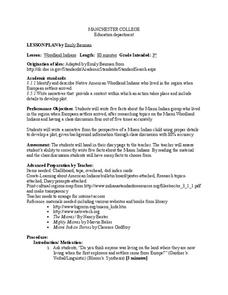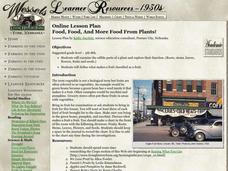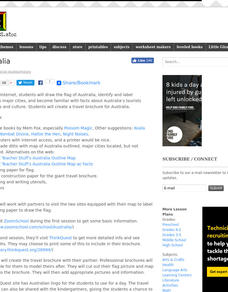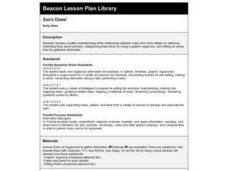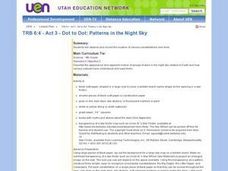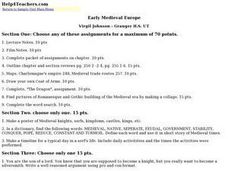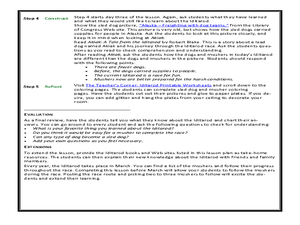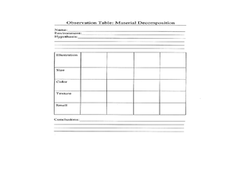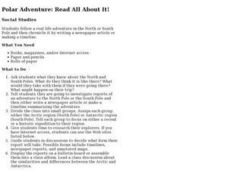Curated OER
Woodland Indians
Third graders research Woodland Indians. In this Woodland Indian lesson, 3rd graders have a classroom discussion and write facts about the Miami Indian group. They write a narrative from the perspective of an Indian child.
Curated OER
Food, Food, And More Food From Plants!
Young scholars examine the edible parts of a plant and explore their function. They define what makes a fruit classified as a fruit. They create a sketch or map or photo of a 1930s farm and justify their plant selections.
Curated OER
Australia
Students research Australia using the Internet. They draw a flag, identify and label Australia's major cities. They discover facts about Australia's tourists attractions and culture. They design a travel brochure using the facts.
Curated OER
Zoo's Clues!
Students determine the difference between major and minor details after researching animals and completing graphic organizers. They write descriptive paragraphs for classmates to guess what animal is being described.
Curated OER
Dot to Dot: Patterns in the Night Sky
Sixth graders are introduced to several major constellations and locate them in the night sky. They graph the constellations on grid paper and work in groups to research common myths and stories associated with specific constellations.
Curated OER
Case Study: Hutu and Tutsi
Students analyze the ethnic conflict between the Hutu and Tutsi in Rwanda and Burundi. They identify the three elements of ethnic conflict, read a handout and answer questions, examine a timeline, conduct research, and write an essay.
Curated OER
Enhancing Students' Problem-Solving Abilities
Students analyze the results of a hypothetical cloning experiment using a restriction endonuclease map obtained from an on-line data source. They answer the question, "How can I tell if the DNA I have obtained from this hypothetical...
Curated OER
Early Medieval Europe
Students engage in a host of activities during an examination of early Medieval Europe. They draw coats of arms, make collages of architectural designs, and create posters of knights, serfs, and castles. Students role-play as sons of...
Curated OER
Where Do I Come From?
Students research immigration from Europe to the United States. For this immigration lesson, students read the book, The Long Way to a New Land. Students use a world map to locate Sweden and other countries in Europe. Students pretend...
Curated OER
Nonfiction Text elements
Young scholars research Lewis and Clark and use the information for a book. In this Lewis and Clark lesson, students gather information and complete worksheets in an activity to write a book. Young scholars use a variety of...
Curated OER
Twain: Steamboat's a-Comin'
Students discover how rivers inspire creative expression. In this Mark Twain instructional activity, students list songs about rivers and discuss common characteristics. They locate the Mississippi River on a map and write a script...
Curated OER
Early Settlements
Students embark on a journey through colonial times. In this early settlement lesson, students come to understand what life was like for the settlers in the early colonies. Students research and create projects illustrating their...
Curated OER
Native American Dolls
Students examine Native American dolls. They discover the connections between the dolls and the Native American culture and customs. They also use maps to locate the position of different tribes.
Curated OER
Creating Stories Using Pictographs
Fourth graders research pictograph stories written by Native Americans. They investigate the history behind pictographs, and look through a reference book identifying the different pictures. The teacher then create their own individual...
Curated OER
Cherishing the Water of Life
Students work in small groups to brainstorm a list of all creatures, plants, natural, and artificial processes that use or depend on fresh water. The class views an aquarium filled with water representing all the water in the world. The...
Curated OER
What Does Bird Flu Mean to Students?
Learners consider the far-reaching effects of the avian flu. In this personal health activity, students visit selected websites to discover information about the flu, viral infections, and intensive farming. Learners...
Curated OER
Order, Order
Third graders practice creative writing by making a book. In this book publishing lesson, 3rd graders investigate the steps needed to publish anything by researching the Internet. Students collaborate on a list of 5 steps to...
Curated OER
Johnny Appleseed or John Chapman: Which Character is Your Favorite?
Students study the life of John Chapman and compare it with the fictional character, Johnny Appleseed. Students listen to books about Johnny Appleseed, and watch a video and PowerPoint if available. They make a KWL chart, make an online...
Curated OER
Mississippian Gardens
Young scholars research and plan a Mississippian garden. In this Native American history lesson, students work in groups to research crops used by Native Americans in the Mississippian Period and use the information to plan and...
Curated OER
The Iditarod: The Last Great Race
Students investigate the Iditarod. In this last great race lesson, students explore and research the Iditarod race which takes place in Alaska. Students explore a variety of websites and images to gather background information. A...
Curated OER
Slow Rot or Not?
Fifth graders examine how environmental factors affect decomposition. In this decomposition lesson plan, 5th graders experiment with the decomposition of grapes in five different environmental settings. They look at images of items that...
Curated OER
Comparing Countries
Students use a graphic organizer to research, compare and contrast two countries. They write a brief (or detailed - depending on age) report of their findings.
Curated OER
Physics Park
Students research and design a playground for a park or school in their community. They explore the physics concepts that are present in the design and, if applicable promote their ideas to city or school officials.
Curated OER
Polar Adventure: Read All About It!
Students investigate reports of an adventure to the North Pole or the South Pole and then chronicle it by writing a newspaper article or making a timeline. The focus is placed on a recent or historic expedition to the region selected.
